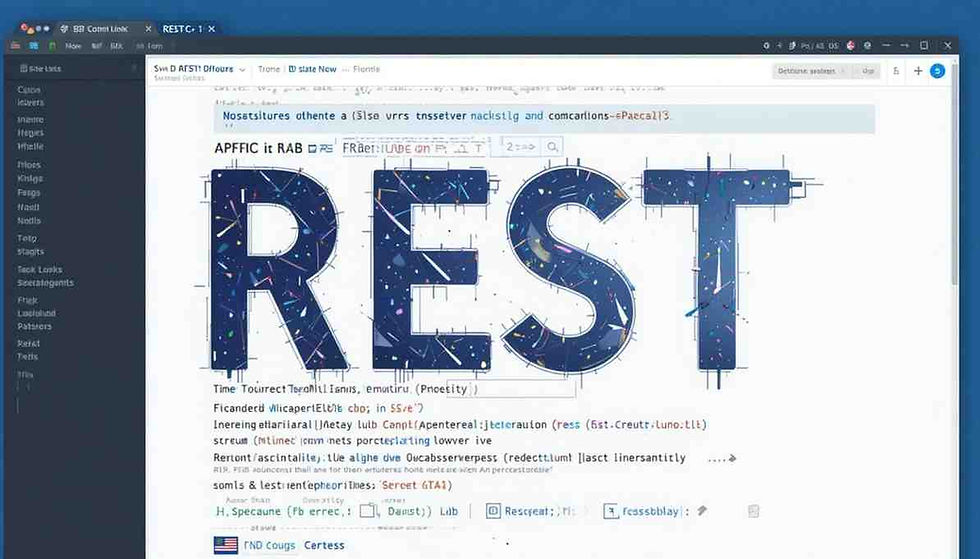What is the 404 API Code? Explained Clearly
- Gunashree RS
- Apr 5
- 4 min read
Introduction
Have you ever encountered an error message like "404 Not Found" while using a web application or testing an API? You’re not alone. The 404 API code is one of the most common HTTP status codes, but what does it truly mean, and how should you handle it as a developer or user?
This comprehensive guide will explain what the 404 API code is, why it occurs, how to troubleshoot it, and the best practices to prevent it in your APIs or web applications. Whether you're a backfront-endfrontend engineer or just curious about how the web works, this article is your complete reference.

What is the 404 API Code?
The 404 API code is an HTTP response status code which means the server could not find the requested resource. It is part of the 4xx class of HTTP status codes, which indicate client errors.
In simple terms:
If your API call returns a 404, it means the endpoint you’re trying to reach doesn’t exist on the server.
🔍 Definition Breakdown
404 – Numeric code representing "Not Found."
API – Application Programming Interface, which allows software to communicate.
HTTP Status Code – Standardized code used to indicate the outcome of a web request.
So, a 404 API code specifically tells developers: 👉 “You made a request to a resource that isn’t on the server.”
Why Does a 404 API Code Occur?
Here are the most common reasons:
Incorrect URL or Endpoint You might be calling /api/users/1234 when the correct route is /api/user/1234.
Resource Doesn’t Exist The user ID or data you’re requesting may not be present in the database.
Routing Configuration Issues Misconfigured backend routes or broken links in code can trigger 404 errors.
Deprecated or Removed APIs Older API endpoints may be phased out or renamed without redirection.
Typos in API Calls Even a small typo can cause the server to reject the request with a 404.
404 vs Other API Error Codes
Status Code | Meaning | When It Occurs |
200 | OK | Request successful and resource returned. |
400 | Bad Request | The request is malformed or invalid. |
401 | Unauthorized | Missing or invalid authentication. |
403 | Forbidden | Access is denied even if credentials are provided. |
404 | Not Found | The server cannot find the requested resource. |
500 | Internal Server Error | The server failed to process the request. |
How to Fix 404 API Code Errors
✅ For Developers
Double-check the URL and Endpoint Use logging and debugging tools to verify the request path.
Validate Request Data Ensure that the IDs, names, or values you're passing actually exist.
Update Routing Logic Make sure your server routes are registered correctly in your framework (Node.js, Django, etc.).
Create Fallback Endpoints Set up a default 404 handler to log unexpected requests for debugging.
Enable Redirection If you’ve changed your API structure, redirect old routes to the new ones.
✅ For End Users or Testers
Check if the URL is correct.
Confirm the resource exists.
Contact support or the API provider if unsure.
How to Prevent 404 Errors in APIs
Use API documentation tools like Swagger or Postman.
Implement versioning in your API (/v1/users).
Monitor traffic for broken requests.
Run automated tests to validate endpoints.
Real-World Example
❌ Failing API Call:
http
GET https://api.example.com/userss/101
Response: 404 Not Found✅ Corrected API Call:
http
GET https://api.example.com/users/101
Response: 200 OKFAQs:
Q1. Is 404 an error or just a message?
A: It's an error response from the server saying it couldn't find what you requested.
Q2. Can I fix a 404 error from my side?
A: Yes, if the issue is with the URL or ID you’re requesting.
Q3. Does a 404 error mean the server is down?
A: No. It means the server is up but can’t find the requested resource.
Q4. How is a 404 different from a 500 error?
A: A 404 is a client-side issue. A 500 is a server-side failure.
Q5. Are 404 errors logged automatically?
A: Most modern servers log 404 errors by default for monitoring.
Q6. Should I return 404 for private content?
A: No. Use 403 (Forbidden) to indicate restricted access.
Q7. Do search engines penalize sites with 404 errors?
A: Not directly, but too many broken links can hurt UX and rankings.
Q8. Can APIs return custom 404 messages?
A: Yes, many APIs return JSON error bodies with messages and codes.
Conclusion
The 404 API code is a fundamental part of web communication. It signals that a requested resource could not be found — often due to a wrong URL, missing data, or outdated endpoint.
Understanding how to handle and prevent 404 errors improves the stability and reliability of any API-based system. Whether you’re debugging code or setting up routes, keep the 404 response in mind—it’s not just an error, it’s a message.
🔑 Key Takeaways
404 API code means "Not Found" – the resource isn't on the server.
Common causes include typos, missing data, or incorrect endpoints.
Fixing 404s improves user experience and API reliability.
Prevent 404s using monitoring, logging, and automated testing.
APIs should return helpful messages along with the status code.
Client-side errors like 404 must be handled gracefully.




Comments